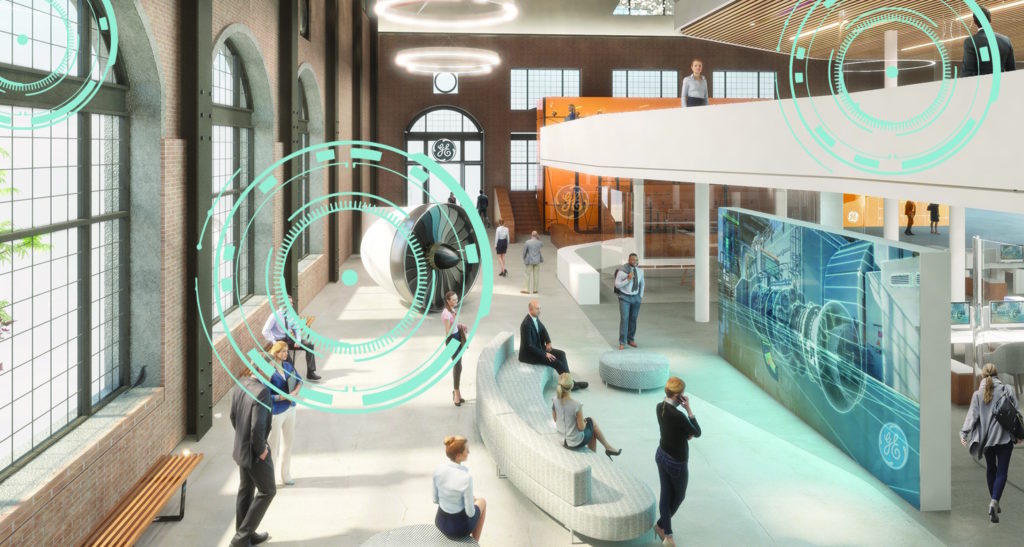Transforming or designing culture requires changing individual and collective behavior.
One of the greatest values to be gained from design thinking is the impact it can have on the culture of an organization and how it contributes to greater collaboration and innovation, regardless of its size.
Designing Culture: The Example of GE
In 2016, General Electric’s (GE) revenue topped $123 billion. GE has more than 330,000 employees operating in over 180 countries. It comes as no surprise that in a commentary published in April 2017, John G. Rice, the company’s vice chairman, shared his observation that it’s natural for a business of GE’s size and scale to see silos manifest along the way. He pointed out that the sharing of ideas and collaboration necessary to be innovative, and the ability of employees or team to add new value, have always been a challenge for the company:
Without a radical shift in everyday working behavior—in employee’s relationships with the company and one another—silos will remain, and the sort of cross-industry and horizontal collaboration that companies like GE need to foster for growth is not going to happen.
John G. Rice, Vice Chairman, GE
For any organization to undergo the continuous change required to sustain and grow, and to be innovative, its leaders and employees need to understand the tension between the paradigm of consistency offered by its culture and the ambiguity necessary for change. This means that they must be able to, at a root level, both trust in the necessity of their culture to evolve, while not relying on or creating unnecessary conditions of predictability.
It also requires being responsive to what is required to attract and leverage the ever-evolving world of talent.
Attracting creative talent
One of the keys to attracting creative talent is to create a culture that thrives on continuous learning and risk-taking.
This requires creating shifts in the culture to interest the new generation in the workforce, a group that wants to engage in a set of work experiences that are radically different from those of the past—a set of experiences that call for the greater levels of participation, and more collaborative and fast-paced ways that design thinking affords. It is about a more creative and engaging way to work and innovate together.
In its effort to become more design thinking–focused, GE moved its headquarters to downtown Boston.
Of the 800 positions at its new headquarters, 600 are designers, developers, and product managers—all evidence of the shift from being engineering-driven to design-driven, from product-centric to customer-centric, and from marketing-focused to user experience–focused. It’s also a sign of the need for executives to collaborate more with designers, design thinkers, and design leaders.
In a September 2016 interview with the Aspen Institute’s Walter Isaacson, when asked about the rise of the creative class and the company’s move to Boston, GE’s CEO Jeff Immelt explained:
I have to say it’s real. I thought it was a little bit of B.S. initially, I wasn’t sure. And when I looked out the window — when I was in Connecticut, it was beautiful, awesome, great office — but when I looked out my window, I saw nothing, there was nothing going on. I could watch cars go on the highway, things like that. I’ve been [in] Boston now six weeks and you just walk out the door. You’re in the middle of an ecosystem that quite honestly, for a big company, it makes you afraid. You’re where the ideas are. You get more paranoid when you’re doing that and that’s a good thing.
Jeff Immelt, CEO, GE
And how else is GE’s new headquarters different? “The new headquarters will be leaner, faster and more open with a constant flow of industry partners, customers and innovators.” The intent, execs say, “[i]s that it will be more like walking into a start-up in an urban setting than the remote suburban headquarters of the past,” helping to transform its culture from a functionally driven one with silos, to a culture focused on collaborative design thinking and creativity.

From fear to transformation
What keeps us from realizing the tension between predictability and the ambiguity of change, the kind of real change that offers the opportunity for an organization to transform itself, and shift its culture?
One of the requirements to successfully implement design thinking to produce change and spark innovation is having a framework to understand culture. What is needed is a definition of culture and a means through which to assess the various aspects of an organization’s behavioral traits and leadership influence.
What culture does more than anything else is inform and reinforce its members how to individually and collectively attain success. It’s how to behave
The definition of what success is and how it happens is as unique to the organization as it is to an individual’s role. Culture speaks to the various aspects of behavior associated with attaining success. It includes the behaviors that support achievement or get in the way of it, resulting in a set of expectations and an understanding as to what is acceptable and unacceptable behavior.
One of the more powerful aspects of design thinking is its influence on culture. All organizations and businesses, including those that are much smaller, will encounter similar problems. Yes, the bigger you get, the more complex and difficult communication and collaboration become. Yet if you look at it through the lens of what drives these potential outcomes, the path takes us back to human behavior.
Cultures don’t create people. People create cultures.
Edgar Papke is the co-author of Innovation By Design and author of True Alignment and The Elephant In The Boardroom. He helps leaders and their organizations align to create greater levels of innovation, performance, and fulfillment. He can be reached by email: edgar@edgarpapke.com